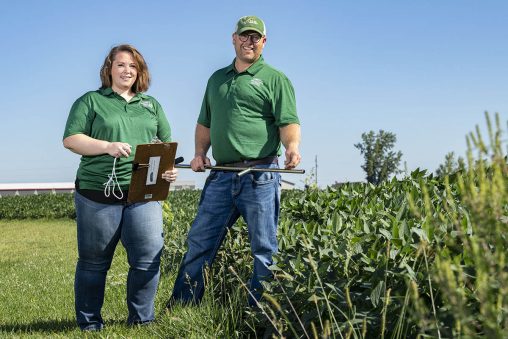
Aubrey Jaqueth, left, and Greg McGlinch, co-direct of the Agriculture Program at Wright State’s Lake Campus.
The Wright State University–Lake Campus Agricultural Program was born out of a community need and, over the past decade, has transformed into an innovative, highly interactive program that not only teaches students modern farming practices but also helps them to understand the science and relationship that farming has with the environment.
Lake Campus is situated in Mercer County and near Darke County, the number one and two agricultural counties in Ohio. Mercer County is also number two in the nation for egg laying and production and also one of the top producers of soy and corn.
“There was a need for education here because a lot of the students want to still be actively farming while participating. And it wouldn’t be practical for them to drive several hours to go to school. So, the goal was to meet the needs of the local community,” said Greg McGlinch, Ph.D., assistant professor at Lake Campus and co-director of the Agricultural Program.
Students can pursue an Associate of Technical Study, a Bachelor of Technical and Applied Studies with a focus on agriculture or an Agricultural Business Management Certificate.
Because of the location and the willingness of the local farming community to work with the Lake Campus, students are afforded an exceptional opportunity for hands-on research, access to industry experts and a chance to see the fruits of their education and research in real-time with a plethora of local farms, sometimes their own, serving as a practical classroom or research space.
“We are small but we are mighty because of the great community that backs us up,” said McGlinch.
The program is also unique in that it works closely with Wright State’s Department of Earth and Environmental Sciences and the local farming community to teach practical approaches to environmentally sustainable farming practices. Researchers have been trying to improve the water quality of Grand Lake St. Marys, the 21-square-mile lake for which the campus is named.
Aubrey Jaqueth, Ph.D., assistant professor of agriculture and co-director of the Agricultural Program, said that one of these research projects, which was made possible by an Ohio Sea Grant, tracks prosperous isotopes after major rainfall events.
“We are collecting samples of stream water that are going into Grand Lake St. Marys and looking for samples of phosphorous isotopes,” Jaqueth said. “We then compare them to those from manure samples of different types of livestock to see if we can trace the phosphorous in our watershed and find out where it’s coming from.”
Jaqueth said that this data can be used by soil and water conservation as a tool to better track where these nutrients are coming from and the relationship between sources such as cattle production and compare natural and synthetic fertilizer and the isotopes that are being assessed.
McGlinch said that they are working with saturated buffers that take tile water and diverts it into a grass buffer that filters out these nutrients before they reach the creek. He said that there are few of these in Ohio and that the practice is more commonly used in Iowa where it was developed.
Both McGlinch and Jaqueth said that they have seen a marked improvement in the relationship between the farming and environmental communities since Wright State brought them together.
Before that, McGlinch, who has lived in the community his entire life, said that the issue of nutrient pollution in Grand Lake St. Marys was adversarial.
“It was always kind of environmental and ag butting heads. But the cool thing about the community here is that eventually environmental and ag began to mesh. And now we’ve got this collaborative partnership to get things cleaned up,” he said. “In this part of the state I have to say, in agricultural and environment practices, we are at the forefront of trying, implementing and adopting new environmental practices.”
Outside the classroom, students have a number of opportunities to learn and network. The Collegiate Young Farmers Club, which was recently re-affiliated with the Farm Bureau, brings in industry speakers and provides students with the opportunity to engage in service projects.
Students also have opportunities to volunteer for research projects and out-of-state tours to learn about the different aspects of agriculture and how it is important in that region and how it relates back to Ohio.

 Museum-quality replica of historic Hawthorn Hill donated to Wright State
Museum-quality replica of historic Hawthorn Hill donated to Wright State  Wright State celebrates more than 1,000 graduates at fall 2025 commencement
Wright State celebrates more than 1,000 graduates at fall 2025 commencement  2026 Alumni Achievement Awards celebrate distinguished Wright State community members
2026 Alumni Achievement Awards celebrate distinguished Wright State community members  Bags, boards and bonding
Bags, boards and bonding  More than 1,000 students to graduate at Wright State’s fall commencement ceremonies
More than 1,000 students to graduate at Wright State’s fall commencement ceremonies 